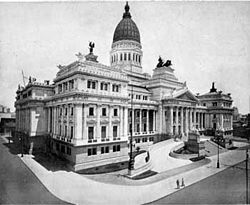Architecture of Argentina
This article possibly contains original research. (August 2007) |
| Part of a series on the |
| Culture of Argentina |
|---|
 |
| Society |
|
| Topics |
| Symbols |
|
|
The architecture of
History

The simplicity of the
Italian and French influences increased after the
.A number of young Italian architects, including
The architecture of the second half of the 20th century continued adapting French
However, after the early 1930s, the influence of
This search for identity is reflected in the

Since the latter part of the 20th century, Argentine architects have become more prominent in the design of prime real estate projects in the country, such as the
Argentine neighborhoods are characterized by highly independent designs for each building. Most houses have individual designs. Tract housing is near to non-existent, generally reserved for subsidized houses made by the state for the poorest.
See also
- List of tallest buildings in Argentina
- Kavanagh Building
- Mar del Plata style
- Casa Argentina del Arte Correo
Gallery
-
The pre-Inca fortification Pucará de Tilcara, Jujuy Province
-
Jesuit Block, Córdoba
-
Baroque style church of San Ignacio Miní, Misiones Province
-
Neo-Renaissance Colón Theatre, Buenos Aires
-
Beaux-Arts Club Argentino, Bahía Blanca
-
Eclectic style Palacio de Aguas Corrientes, Buenos Aires
-
Art Nouveau Barolo Palace, Buenos Aires
-
Art Deco Kavanagh Building, Buenos Aires
-
Rationalist Alas Building, Buenos Aires
-
Argentine National Library, Buenos Aires
-
Casa Chorizo, Buenos Aires
External links
![]() Media related to Architecture of Argentina at Wikimedia Commons
Media related to Architecture of Argentina at Wikimedia Commons














